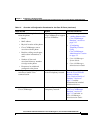
1-7
Cisco IP Phone Administration Guide for Cisco CallManager 3.3, Cisco IP Phones 7902G/7905G/7912G
OL-6313-01
Chapter 1 An Overview of the Cisco IP Phone
What Networking Protocols Are Used?
What Networking Protocols Are Used?
Cisco IP Phones support several industry-standard and Cisco networking
protocols for voice communication. Table 1-1 provides an overview of the
networking protocols that the Cisco IP Phone models 7902G/7905G/7912G
supports.
Table 1-1 Supported Networking Protocols on the Cisco IP Phone
Networking Protocol Purpose Usage Notes
Cisco Discovery
Protocol (CDP)
CDP is a device-discovery protocol that
runs on all Cisco-manufactured
equipment.
Using CDP, a device can advertise its
existence to other devices and receive
information about other devices in the
network.
The Cisco IP Phone uses CDP to
communicate information such as
auxiliary VLAN ID, per port
power management details, and
Quality of Service (QoS)
configuration information with the
Cisco Catalyst switch.
Dynamic Host
Configuration Protocol
(DHCP)
DHCP dynamically allocates and assigns
an IP address to network devices.
DHCP enables you to connect an IP
phone into the network and have the
phone become operational without you
needing to manually assign an IP address
or configure additional network
parameters.
DHCP is enabled by default. If
disabled, you must manually
configure the IP address, subnet
mask, gateway, and an TFTP
server on each phone locally.
Cisco recommends that you use
DHCP custom option 150. With
this method, you configure the
TFTP server IP address as the
option value. For additional
supported DCHP configurations,
see Cisco CallManager System
Guide.


















